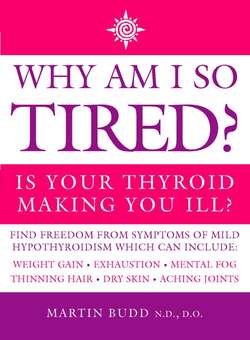Читать книгу Why Am I So Tired?: Is your thyroid making you ill? - Литагент HarperCollins USD, Martin Budd N.D. D.O. - Страница 15
The Problems of Diagnosis
ОглавлениеMany people suffering from chronic fatigue do not fit into a neat medical pigeon hole. This situation has unfortunately lead some medical doctors to define chronic fatigue as psychosomatic (mind-body). This diagnosis is often followed with a prescription for drugs to treat anxiety and/or depression.
There may be no evidence of disease or damage with fatigue, but there is often evidence of malfunction. Functional medicine recognizes that the simple under-efficiency of a gland, organ or system, can give rise to symptoms. Nowhere is this more clearly shown than in mild or low grade hypothyroidism. This concept of imbalance or mild hypofunction rarely applies to a single function. The domino effect often applies to ill health.
The concept of several poorly functioning but non-diseased glands has been termed multiple enzyme deficiency syndrome (MED), polyendocrine syndrome (PS) or polyendocrinopathy.
An underactive thyroid can lead to adrenal exhaustion, muscle pain, fatigue, obesity, depression and a host of other symptoms. With many health problems there exist recognizable degrees of severity. This can be seen very clearly in diabetic patients. The diagnosis of diabetes can range from a mild glucose intolerance in old age needing care with carbohydrate foods, to a severe diabetic requiring three or four insulin injections daily to stay alive. This concept of ‘shades of grey’ can be applied to almost any illness. Unfortunately a certain standardization of definitions is required in order to determine drug dosages and treatment protocol, so many conditions are diagnosed in terms of ‘black or white’. Hypothyroidism is seen as either severe enough to warrant a lifelong prescription for thyroxine or normal and no treatment is offered.
Functional assessment requires a more sensitive awareness of test results based on a full knowledge of the patients symptoms. Unfortunately many British GPs are simply given a patient’s test results, stating ‘normal’. Yet it is the GP who is in contact with the patient, not the laboratory staff. The diagnosis of mild or early-stage imbalances can easily be missed with this method. The need for more sensitive tests to assess disorders of function, and mild deficiencies or excesses, has lead in the last 10 years to the development of a range of specific laboratory tests. These have included tests to measure or identify leaky gut, malabsorption, candidiasis, gut transit speed, stomach emptying speed, pancreatic enzyme status, 24-hour adrenal function tests and many more.
Therefore the key to understanding the reasons for your fatigue consists of careful test selection and subsequent test interpretation. When this is carried out efficiently and assessed alongside the symptoms you may feel, some understanding of your problem can be achieved and an accurate diagnosis arrived at. Although changes to diet and supplement use are usually harmless, the good response to any treatment depends on specificity (see page 148). The correct supplements and dosages and the appropriate food and drink are always preferable to guesswork. Once you have drawn together a symptom picture as shown in Part Two, and armed with the results of your practitioner’s tests, you can begin to recover from your tiredness and enjoy renewed vitality and well-being.
